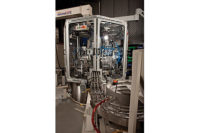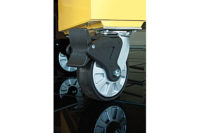Optimizing product quality is an ongoing challenge for all employees of Robert Bosch GmbH, the world’s largest supplier of automotive components. To achieve its goal, the company often turns to PA-AMTO, an in-house provider of assembly systems and specialized equipment.
PA-ATMO’s responsibilities include testing leak-detection procedures and developing leak-testing systems for several company divisions. One division is gasoline services, which manufactures specialized gas injection and engine control systems in Bamberg, Germany.
At that plant, PA-ATMO recently leak tested a new valve for bifuel (gasoline and natural gas) engines. Initially, a conventional helium-based detector was used. It featured high-vacuum chambers and had a detection limit of 1x10-11 millibar liter per second.
“However, the cost-benefit ratio was not optimal, due to its high investment and operating costs,” notes Franziska Seitz, a development engineer for Robert Bosch. “[Because] we’re testing for leakage rates of 4x10-4 millibar liter per second, it [was] a little bit like using a canon to hit a tennis ball.”
Bosch wanted PA-ATMO’s engineers to find a helium-based detector that did not require expensive vacuum technology. In May 2013, the engineers learned about the T-Guard detector at the Control international trade show, and they immediately ordered one.
Made by Inficon, the T-Guard features a Wise Technology sensor with a quartz membrane that separates helium out of the test atmosphere under normal air pressure—eliminating the need for expensive vacuum chambers, mass spectrometers and molecular pumps. The sensor reliably detects a helium concentration increase of 25 parts per billion (0.025 part per million), and it verifies leaks in the range of 10-6 millibar liter per second.
The detector is unaffected by heat and moisture on the test pieces or in the surrounding environment. Plus, it can be used to test parts affected by vacuum, such as those made of plastic.
Bosch likes that the detector is compact (258 by 130 by 272 millimeters) and lightweight (10 pounds). It features easy-to-reach connections that allow for quick integration into the assembly line. With no expendable parts, the detector requires little maintenance.
“For our requirements, the high reproducibility is ideal,” notes Michael Urhahn, a development engineer for Robert Bosch. “Now we just have to perform one sensor referencing procedure per work shift. The control software can be adapted to our individual needs.”
PA-ATMO developed a test system for the bifuel valves that has four parallel stations. Each station features a T-Guard leak sensor and a vacuum chamber with a volume of 1 liter.
The new system takes up less floor space and offers higher productivity than the conventional detector. It tests up to four valves simultaneously, whereas the old system only tested one. Cycle time is 5.6 seconds.
“Energy consumption is eight times lower, and the uptime is substantially higher,” adds Urhahn. “If a component fails, replacing it and setting up the test again is fairly straightforward.”
PA-ATMO employees also like having immediate access to T-Guard sensor data. It allows them to make a comprehensive evaluation of the test settings and process.
Seitz says that Bosch plans to use the T-Guard to test fuel pumps and filters, as well as exhaust sensors and control electronics, which are low-volume components with complex geometries.
Electromobility is also being considered. Individual battery cells are consolidated to form a battery with a volume of up to 500 liters. However, because the battery is too compact to leak-test individual cooling system components, the entire system is tested inside a chamber with a volume of 3,500 liters.
“We visualize using [T-Guard] on practically all of Bosch’s products,” says Seitz. “It can measure the leak-tightness of products that were otherwise not measurable in the past.”
For more information on leak-detection sensors, call 315-434-1100 or visit www.inficon.com.





